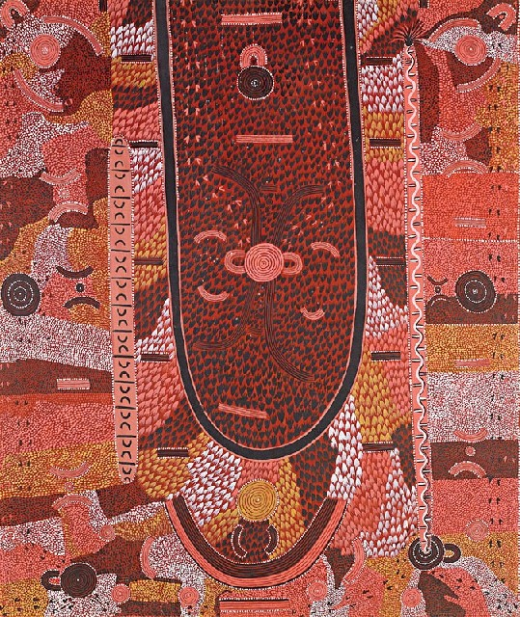Kaapa Mbitjana Tjampitjinpa, circa 1926-1989, WARRU (WALLABY) ANCESTORS
Kaapa Mbitjana Tjampitjinpa, circa 1926-1989, WARRU (WALLABY) ANCESTORSEstimate $100,000 – $150,000
synthetic polymer paint on linen
bears Papunya Tula Artists catalogue number 74403K on the reverse
203 BY 173CM
Provenance:
Painted at Papunya during April 1974
Papunya Tula Artists, Alice Springs
Private collection
This painting is sold with a copy of the accompanying Papunya Tula Artists certificate with an annotated diagram and description of the story depicted in Peter Fannin's hand. The certificate reads: 'Nancy Munn (Wailbri Iconography, Cornell, 1973) knows of at least 150 different ancestors. As well as animals, plants and fire are used. It is known that union with a man is necessary for pregnancy, but the actual embryo enters the women as a missile cast by a child-like servant of the ancestor dreaming.
Each ancestor has one or more iconograph patterns. For the Warru Wallaby the four arcs leading from the centre are lines of corroboree paint on the front of shoulders and arms. In a very similar pattern for the Mala Wallaby the arcs are described as double representation of Mala's beard. Returning to Warru, the iconograph is complete with two seated figures and four arcs of ceremonial paint.
The whole painting describes a corroboree that brings the Warru ancestors alive again. Their meeting with the Water Men from Kalipinypa is related on a ceremonial wanatanji used in the corroboree'.
The painting is a depiction of an extravagant ceremony conducted by the Warru Wallaby Men to celebrate fertility in natural species and, in particular, humans. The highly ordered nature of the composition reflects the systematic progress of the ritual.
The main feature of the work is the large U-shape representing a cave. Within this, the set of central concentric circles with four long arcs emerging from it is the symbol of Warru. This design is painted onto the chests and arms of participants. To each side of the central roundel is a small U-shape indicating the performers at the ceremonial ground. The two arcs on either side represent the designs painted on to the body. Wallaby tracks have been depicted running from the central circle to the top of the painting.
To the right of the cave is a long vertical ceremonial pole of the type placed in a ritual ground painting (concentric circles in the bottom register beside a man, the U-shape). Wallaby tracks can be seen leading up to and away from the base of the pole. The pole carries a design of a meander indicating running water or rain, and to either side are a series of parallel double bars indicating clouds. The pole recalls the meeting of the Warru ancestors with the Rain Ancestors from Kalipinypa.
Other salient features of the painting include a number of additional ceremonial sites in each corner of the painting, and again at the lower middle ground, enclosed by a large parallel arc representing a wind-break. To the left of the cave is another vertical sacred object. Along each side of the work, the icons comprising a circle with two U-shapes turned away from the roundel represent participants sleeping beside fires.
The background patterns around the sides of the painting indicate vegetation while that of the central part and inside the cave may indicate the bird down that participants use to cover their bodies.'

